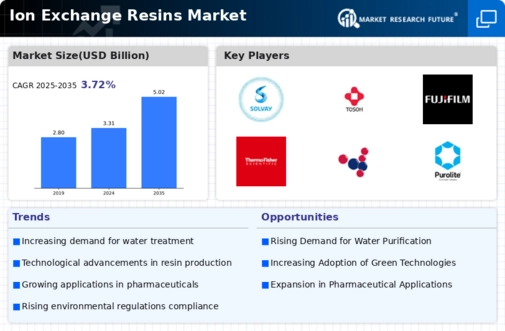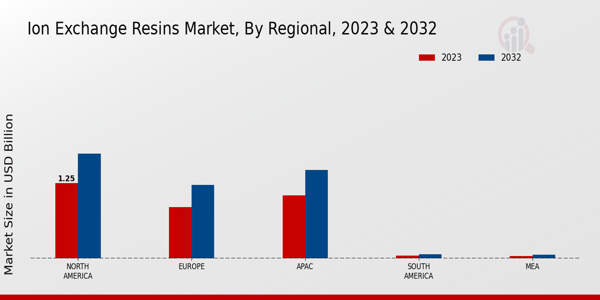Ion Exchange Resins Size
Ion Exchange Resins Market Growth Projections and Opportunities
The Ion Exchange Resins Market is influenced by various market factors that shape its dynamics and growth trajectory. These factors play a crucial role in determining the demand, supply, and overall performance of ion exchange resins in different industries. One significant factor is the increasing demand for clean water across the globe. With growing concerns about water pollution and the need for safe drinking water, there's a rising adoption of ion exchange resins in water treatment processes. This demand is driven by both municipal and industrial sectors aiming to comply with stringent regulations regarding water quality.
Moreover, the expansion of industries such as pharmaceuticals, food & beverages, and chemicals also contributes to the growth of the ion exchange resins market. These industries extensively use ion exchange resins for various applications including purification, separation, and catalysis. The pharmaceutical sector, in particular, relies on high-quality ion exchange resins for the purification of drugs and pharmaceutical ingredients. Similarly, the food & beverage industry utilizes ion exchange resins for water softening, decolorization, and purification purposes, enhancing the quality of their products.
Therefore the water treatment procedures and the industrial water purification purposes utilize the ion exchange resins to remove chlorine and other organic compounds.
Another significant market factor is the increasing emphasis on environmental sustainability and regulations promoting wastewater treatment and recycling. As environmental concerns continue to escalate, industries are compelled to invest in advanced wastewater treatment technologies, where ion exchange resins play a vital role. These resins help in the removal of heavy metals, organic pollutants, and other contaminants from industrial wastewater, thereby aiding in environmental protection and regulatory compliance.
Furthermore, technological advancements and innovations in ion exchange resins contribute to market growth. Manufacturers are continuously investing in research and development activities to enhance the efficiency, selectivity, and durability of ion exchange resins. The development of novel ion exchange resin formulations with improved performance characteristics fosters market expansion by catering to diverse application requirements and addressing evolving customer needs.
Global economic conditions also influence the ion exchange resins market. Factors such as GDP growth, industrial output, and investment patterns impact the demand for ion exchange resins across different regions. Economic growth typically leads to increased industrial activities, which, in turn, drive the demand for ion exchange resins used in various manufacturing processes. Conversely, economic downturns may temporarily dampen market growth as industries cut down on expenditures and capital investments.
Moreover, geopolitical factors and trade policies can affect the ion exchange resins market dynamics. Tariffs, trade barriers, and geopolitical tensions between major economies may disrupt the supply chain and pricing of ion exchange resins, leading to market uncertainties. Fluctuations in raw material prices, especially those derived from petrochemical sources, also influence the overall cost structure of ion exchange resins, impacting their market competitiveness and profitability.
Additionally, the competitive landscape and market consolidation play a crucial role in shaping the ion exchange resins market. The market is characterized by the presence of several key players competing based on product quality, pricing, distribution networks, and technological innovations. Mergers, acquisitions, and strategic partnerships among manufacturers further reshape the competitive dynamics, influencing market trends and customer preferences.
















Leave a Comment